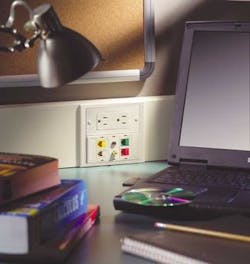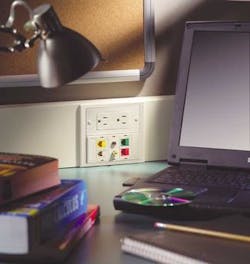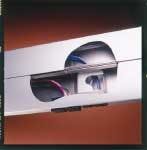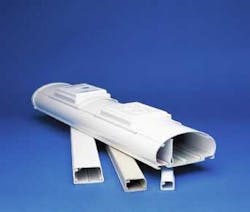New designs focus on aesthetics, security, easy installation, and 10-Gigabit applications.
Many customers and interior designers dislike the appearance of surface raceway for delivering network cabling and power to various locations in a facility. But for many buildings and applications, it is often the only, or the best, choice.
While aesthetics has remained a concern, easy installation and tamper resistance are also important features of surface raceway. Nowadays, the movement towards larger cable diameters to accommodate 10-Gigabit Ethernet (10-GbE) has many wondering if surface raceway will also support technology requirements in the future. With several innovative designs entering the market, customers can choose from several types and sizes designed with aesthetics, installation, tamper resistance, and capacity in mind.
In all types and sizes
"Generally, we first categorize raceway by material; in other words, metal versus nonmetallic," says Ken Woo, product marketing manager for Wiremold (www.wiremold.com). "Metal refers to steel and aluminum while nonmetallic is almost always PVC." According to Woo, aluminum carries a premium over steel, but provides a sleeker look and better corrosive resistance for such applications as research labs or industrial processing.
Metal raceway is more difficult to install than nonmetallic raceway, requiring special cutting tools and deburring of sharp edges. Weight is also an issue. "On a six-foot section of raceway, nonmetallic is typically about one-third less in weight-that means easier shipping, storing, and installation," says Gary Bernstein, RCDD, director of product marketing for HellermannTyton (www.hellermann.tyton.com).
"Many nonmetallic raceway systems can be installed by just one person, but that's not always possible with metal," Bernstein adds. Unlike nonmetallic, metal raceway also requires grounding and bonding throughout the entire system.
Metal raceway is often considered stronger and more reliable than nonmetallic, and many jurisdictions, including Chicago and areas of New York City, still require metal. "A lot of it is perception,” says Paul Siekman, senior product manager for Hubbell Wiring Systems (Hubbell Wiring Device-Kellems and Hubbell Premise Wiring, www.hubbell.com). “Although very durable, metal has the potential to scratch or dent,” Siekman explains. “Nonmetallic raceway won't rust, dent, or scratch. Due to local authorities, in many cities, nonmetallic raceway penetration has been limited."
Raceway comes in many different configurations and sizes to accommodate a wide range of capacities and applications. Some raceway is single channel while some offer multiple channels for power and various types of data cabling. Multichannel raceway can have a fixed channel divider, or a divider that must be installed to maintain physical separation between power and data cabling.
Prewired raceway is available from some manufacturers, but it is wired for power only since data must be a continuous run. Wiremold offers prewired raceway in both metal and nonmetallic single and multi-channel. "With prewired raceway, separate sections are built to specifications and shipped directly to the job site where they are hardwired together," says Woo. "Our studies have shown that electricians can get off the job in one-third the time."
While prewired raceway can cost as much as 20% to 35% more, it is considered ideal for large, repetitive jobs where several rooms are being cabled identically.
Aiming for market demands
Several raceway manufacturers have introduced innovative designs that focus on aesthetics, easy installation, and tamper resistance. "Nobody wants to use surface raceway, and aesthetics has become increasingly important," says HellermannTyton's Bernstein. "In older buildings, a lack of drop ceilings and drywall often requires raceway. This is especially true in buildings with cement-block walls, and that's why we see surface raceway in many schools."
HellermannTyton's InfoStream multichannel raceway, which accepts standard NEMA faceplates, was developed as a competitively priced, aesthetically pleasing raceway with easy installation. (See photo, page 32.) "The elliptical shape of InfoStream is more appealing than clunky square raceways, and the cover acts as a hinge to help hold cables in place during installation," says Bernstein. "Fittings for specific applications include larger entry points for high-density applications and bridge fittings to get around existing raceway or other obstacles on the wall."
Panduit's Pan-Way T-70 and Twin-70 raceway systems provide beveled corners designed for a softer look, while the Pan-Way Cove raceway (pictured above) is a solution for maintaining aesthetics in historic applications. "In many historic buildings, customers want computer technology but they don't want to destroy the historical appearance by putting raceway across the wall," says Steve Lytle, business development manager at Panduit (www.panduit.com). "The cove raceway provides the option of hiding cables up near the ceiling in something that looks very similar to crown molding." Panduit's Pan-Way TG-70 nonmetallic raceway also provides adjustable inside and outside corner fittings for accommodating out-of-square, octagonal, or hexagonal walls.
This month, Wiremold launched its Designer Series 4000 metal raceway in steel and aluminum, which offers a new curved shape, subtle connection points, easy installation, and one-third more capacity than the company’s traditional 4000 series. Available in four colors (ivory, gray, bronze, and matte black), the new Designer Series enables a greater margin of error when cutting, and offers dual covers that let electrical and data cabling be kept completely separate during installation.
"Our Designer series is meant to take raceway from the back room to the front room," says Woo. "One of the biggest features is the patented crossover unit (pictured above), which enables both the power and data outlets to be positioned side-by-side in the same channel."
Typical multichannel raceway requires data connections on one side and power on the other. Wiremold's crossover unit enables data cables to "cross over" the power channel so that both power and data outlets can be located on the downward-facing surface of the raceway. "With both connections facing downward, not only is the raceway more aesthetically appealing but data jacks are less susceptible to damage," says Woo.
In October, Hubbell Wiring Systems introduced Hubbell Metal Raceway, which includes both steel and aluminum types. "Metal raceway was a huge market that we couldn't participate in due to local ordinances in many cities," says Hubbell's Siekman. "The voice of the customer provided us with the opportunity to get into the metal raceway market and round out our product offering." According to Siekman, the addition of metal raceway will enable customers to specify a complete Hubbell data and power package wherever metal raceway is required.
Based on information gathered from surveys and focus groups, Hubbell developed its new metal raceway to address installation, aesthetics, and safety. "Our innovative box design includes the Hubbell Handi-Screw, which is a threaded binding post that eliminates having to use long screws," explains Siekman. "We also moved from an exposed seam construction to a roll-and-tuck methodology that leaves just one seam on the bottom of the box for a much cleaner look." The new Hubbell metal raceway also features rounded corners instead of sharp edges, and a coordinating line of jacks and faceplates with proper color matching.
Hubbell metal raceway includes single-channel and multichannel versions in various sizes, with the 6750 series offering the most capacity. "The 6750 series offers options for a single channel, two channels with a 1/3-2/3 split, or three equally-spaced channels," says Siekman. The metal raceway line includes UL-classified transition fittings for attaching Hubbell raceway to existing competitor raceway.
On track for 10 Gig
With Augmented Category 6 cable likely to contain cable diameters as large as 0.35 inches to accommodate 10-GbE, manufacturers are confident their surface raceways will support technology requirements in the future.
"Augmented Category 6 will mainly affect raceway at connection points and bends and turns,” says Wiremold's Woo. “If the largest diameter ends up at 0.35, the minimum bend radius will be 1.4 inches. We have fiber-ready fittings that already provide a 2-inch bend radius, and now they can be used for Augmented Category 6."
Wiremold's new Designer Series 4000 will support 23 Augmented Category 6 cables based on the TIA/EIA 40% fill rate, compared to 16 Augmented Category 6 cables with the established 4000 series metal raceway. "We designed the new raceway with the Augmented Category 6 cables in mind," says Woo. "The crossover unit provides a 4-inch bend radius, which is plenty large enough for any Augmented Category 6 cable that hits the market."
HellermannTyton, Hubbell, and Panduit say that fittings for their larger capacity raceways are also ready to accommodate the bend radius for Augmented Category 6 cabling, and none foresees the need to make any alterations to their product line. "Right now, we're not planning on coming out with anything new due to the introduction of Augmented Category 6," says HellermannTyton's Bernstein. "Designers will have to properly plan their installations to achieve proper capacity for Augmented Category 6 while maintaining aesthetics."
According to Panduit's Lytle, accommodating larger cable diameters is currently more of a concern with office furniture. "With older furniture systems, customers were able to squeeze in Category 5e and even Category 6 in some instances,” Lytle says. “But with Augmented Category 6, customers won't be able to route cable to a group of 8 or 10 cubicles. Our Pan-Way office furniture raceway is designed for routing data cabling to the workstation on the top of existing office furniture partitions to provide greater cable capacity."
Most manufacturers agree that their larger capacity raceways may become more popular in the future due to the larger cable diameters, and all are in the process of updating their wire fill charts to include Augmented Category 6. "As more Augmented Category 6 cable enters the market, many customers will look to higher capacity raceway," says Hubbell's Siekman. "We feel that we'll have strong success with our new 6750 series metal raceway and MT10 nonmetallic raceway." When used as a single channel raceway with no divider, the Hubbell 6750 series metal raceway can accommodate up to 57 Augmented Category 6 cables at a 40% fill capacity, while the MT10 nonmetallic raceway can accommodate up to 44 Augmented Category 6 cables.
"It's not likely at this time that the industry will see a raceway product designed solely for Augmented Category 6 cable,” predicts Woo. “With raceway, we rarely see a drop with just Category 6. There's typically something else there as well, like power. But if the technology takes off, it may behoove us to make a raceway to accommodate an application that's solely for 10-GbE over UTP.”
BETSY ZIOBRON is a freelance writer covering the cabling industry, and a frequent contributor to Cabling Installation & Maintenance. She can be reached at: [email protected]




